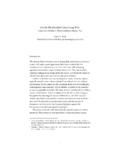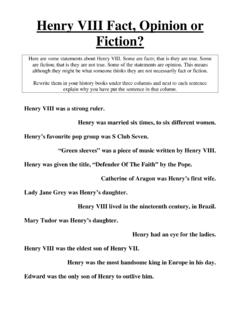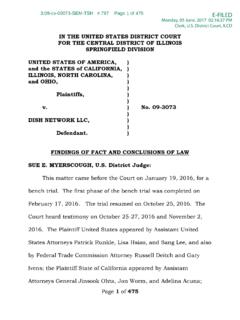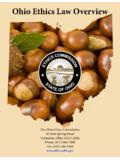Transcription of Orin S. Kerr - volokh.com
1 Second Series Autumn 2007 Volume 11 Number 1 Published by The Green Bag, Inc., in cooperation with the George Mason University School of TO READ A LEGAL OPINIONA GUIDE FOR NEW LAW STUDENTSOrin S. KerrCopyright 2007 Orin S. Kerr 11 GREEN BAG 2D 51 HOW TO READ A LEGAL opinion A GUIDE FOR NEW LAW STUDENTS Orin S. Kerr This essay is designed to help new law students prepare for the first few weeks of class. It explains what judicial opinions are, how they are structured, and what law students should look for when reading them. I. WHAT S IN A LEGAL opinion ? hen two people disagree and that disagreement leads to a lawsuit, the lawsuit will sometimes end with a ruling by a judge in favor of one side.
2 The judge will explain the ruling in a written document referred to as an opinion . The opinion explains what the case is about, discusses the relevant legal principles, and then applies the law to the facts to reach a ruling in favor of one side and against the other. Modern judicial opinions reflect hundreds of years of history and practice. They usually follow a simple and predictable formula. This Orin Kerr is a professor of law at the George Washington University Law School. This essay can be freely distributed for non-commercial uses under the Creative Commons Attribution-NonCommercial-NoDerivs Unported license.
3 For the terms of the license, visit W Orin S. Kerr 52 11 GREEN BAG 2D section takes you through the basic formula. It starts with the intro-ductory materials at the top of an opinion and then moves on to the body of the opinion . The Caption The first part of the case is the title of the case, known as the cap-tion. Examples include Brown v. Board of Education and Miranda v. Arizona. The caption usually tells you the last names of the person who brought the lawsuit and the person who is being sued. These two sides are often referred to as the parties or as the litigants in the case. For example, if Ms. Smith sues Mr. Jones, the case caption may be Smith v. Jones (or, depending on the court, Jones v.)
4 Smith). In criminal law, cases are brought by government prosecutors on behalf of the government itself. This means that the government is the named party. For example, if the federal government charges John Doe with a crime, the case caption will be United States v. Doe. If a state brings the charges instead, the caption will be State v. Doe, People v. Doe, or Commonwealth v. Doe, depending on the practices of that The Case Citation Below the case name you will find some letters and numbers. These letters and numbers are the legal citation for the case. A citation tells you the name of the court that decided the case, the law book in which the opinion was published, and the year in which the court decided the case.
5 For example, Supreme Court, 485 759 (1988) refers to a Supreme Court case decided in 1988 that appears in Volume 485 of the United States Reports starting at page 759. The Author of the opinion The next information is the name of the judge who wrote the opin-ion. Most opinions assigned in law school were issued by courts 1 English criminal cases normally will be Rex v. Doe or Regina v. Doe. Rex and Regina aren t the victims: the words are Latin for King and Queen. During the reign of a King, English courts use Rex ; during the reign of a Queen, they switch to Regina.
6 How to Read a Legal opinion AUTUMN 2007 53 with multiple judges. The name tells you which judge wrote that particular opinion . In older cases, the opinion often simply states a last name followed by the initial J. No, judges don t all have the first initial J. The letter stands for Judge or Justice, depending on the court. On occasion, the opinion will use the Latin phrase per curiam instead of a judge s name. Per curiam means by the court. It signals that the opinion reflects a common view among all the judges rather than the writings of a specific judge. The Facts of the Case Now let s move on to the opinion itself. The first part of the body of the opinion presents the facts of the case.
7 In other words, what happened? The facts might be that Andy pulled out a gun and shot Bob. Or maybe Fred agreed to give Sally $100 and then changed his mind. Surprisingly, there are no particular rules for what facts a judge must include in the fact section of an opinion . Sometimes the fact sections are long, and sometimes they are short. Sometimes they are clear and accurate, and other times they are vague or in-complete. Most discussions of the facts also cover the procedural history of the case. The procedural history explains how the legal dispute worked its way through the legal system to the court that is issuing the opinion . It will include various motions, hearings, and trials that occurred after the case was initially filed.
8 Your civil procedure class is all about that kind of stuff; you should pay very close attention to the procedural history of cases when you read assignments for your civil procedure class. The procedural history of cases usually will be less important when you read a case for your other classes. The Law of the Case After the opinion presents the facts, it will then discuss the law. Many opinions present the law in two stages. The first stage dis-cusses the general principles of law that are relevant to cases such as the one the court is deciding. This section might explore the history of a particular field of law or may include a discussion of past cases (known as precedents ) that are related to the case the court is de-Orin S.
9 Kerr 54 11 GREEN BAG 2D ciding. This part of the opinion gives the reader background to help understand the context and significance of the court s decision. The second stage of the legal section applies the general legal principles to the particular facts of the dispute. As you might guess, this part is in many ways the heart of the opinion : It gets to the bottom line of why the court is ruling for one side and against the other. Concurring and/or Dissenting Opinions Most of the opinions you read as a law student are majority opin-ions. When a group of judges get together to decide a case, they vote on which side should win and also try to agree on a legal ra-tionale to explain why that side has won.
10 A majority opinion is an opinion joined by the majority of judges on that court. Although most decisions are unanimous, some cases are not. Some judges may disagree and will write a separate opinion offering a different approach. Those opinions are called concurring opinions or dis-senting opinions, and they appear after the majority opinion . A concurring opinion (sometimes just called a concurrence ) ex-plains a vote in favor of the winning side but based on a different legal rationale. A dissenting opinion (sometimes just called a dis-sent ) explains a vote in favor of the losing side. II. COMMON LEGAL TERMS FOUND IN OPINIONS ow that you know what s in a legal opinion , it s time to learn some of the common words you ll find inside them.








